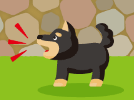Syntax
Internal Links (linking to another page on Cosense)
[link] ⇒ LinkExternal Links (linking to another web page)
http://google.com ⇒ http://google.com [http://google.com Google] ⇒ Googleor
[Google http://google.com] ⇒ GoogleImages
Direct image link ↓
[https://gyazo.com/da78df293f9e83a74b5402411e2f2e01.png] Clickable Thumbnail Links
↓
[http://cutedog.com https://i.gyazo.com/da78df293f9e83a74b5402411e2f2e01.png] Adding the link at the end also works, as before:
[https://i.gyazo.com/da78df293f9e83a74b5402411e2f2e01.png http://cutedog.com] Linking to other Cosense projects
[/projectname/pagename] ⇛ /icons/check [/projectname] ⇛ /iconsIcons
Bold text
[[Bold]] or [* Bold] ⇒ BoldItalic text
[/ italic] ⇛ italic Strikethrough text
[- strikethrough] ⇛ strikethroughBullet points
Press space or tab on a new line to indent and create a bullet point
Press backspace to remove the indent / bullet point
Internal links serve triple duty
[Links] or #links are two ways to make links. They do three thingsAn internal link to a page
A Bi-directional link back to the source
A 2-hop link so you can find more related pages
Block quote
> use the right caret > at the beginning of a line to get a block quote Mouse based styling
Use backquotes or backticks, `, to highlight code
e.g.
function() { return true } Typing
code:filename.extension or code:filename can be used to create a new code snippet and and display it as a blockLanguage names may be abbreviated
hello.jsfunction () {
alert(document.location.href)
console.log("hello")
// You can also write comments!
}Type table: tablename to create a table
Use tab to move to the next column, use enter to move to the next row.
An example:
hello
| 1 | 2 | 3 |
| 1 | 2 | 3 |
| ------ | ------ | ------ |
| a | b | c |
Using TeX inside of brackets with a dollar sign
[$ TeX here ] , you can format math or science formulas, like so: E = mc^2You can even add javascript to customize Cosense to your liking.



